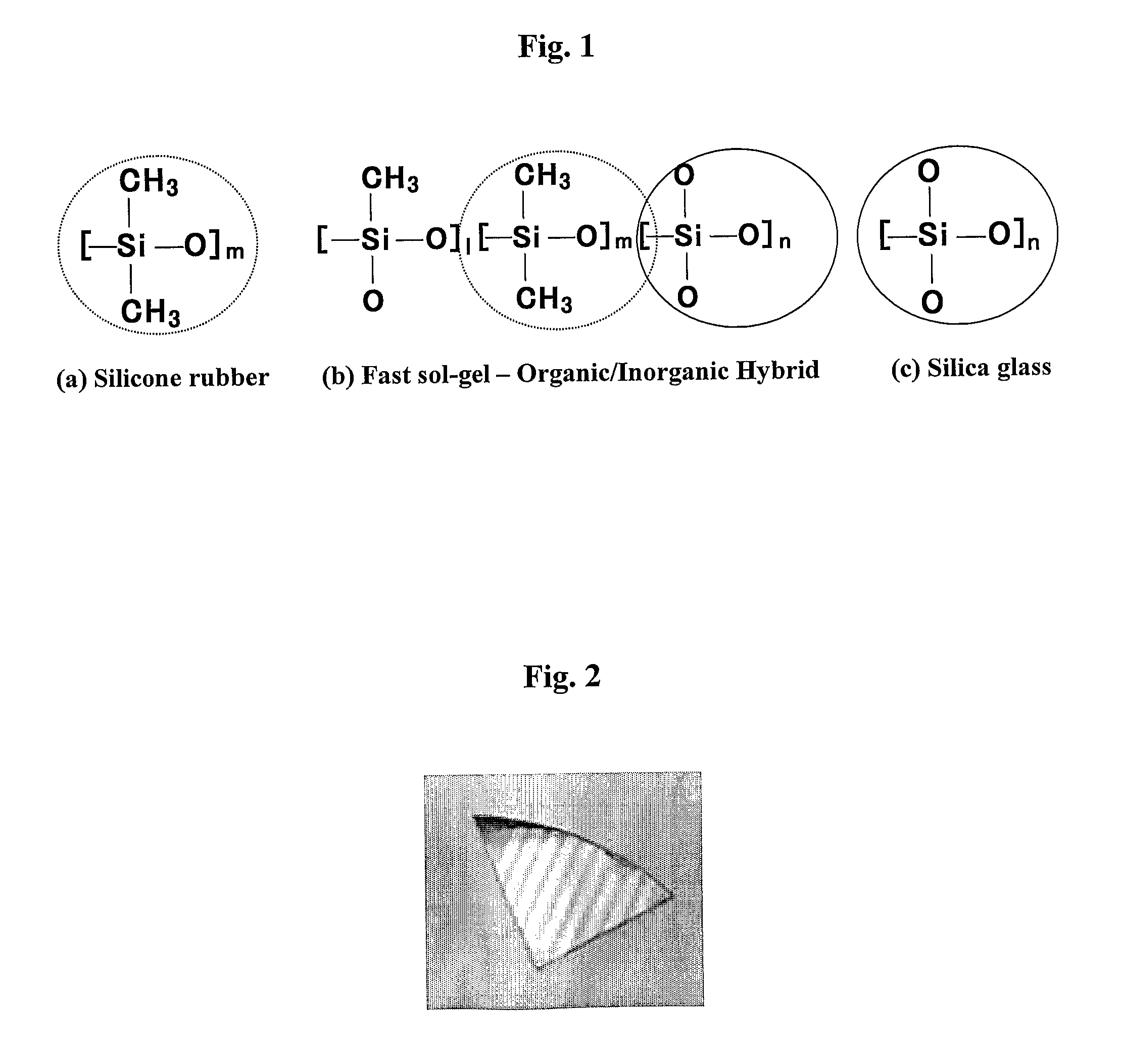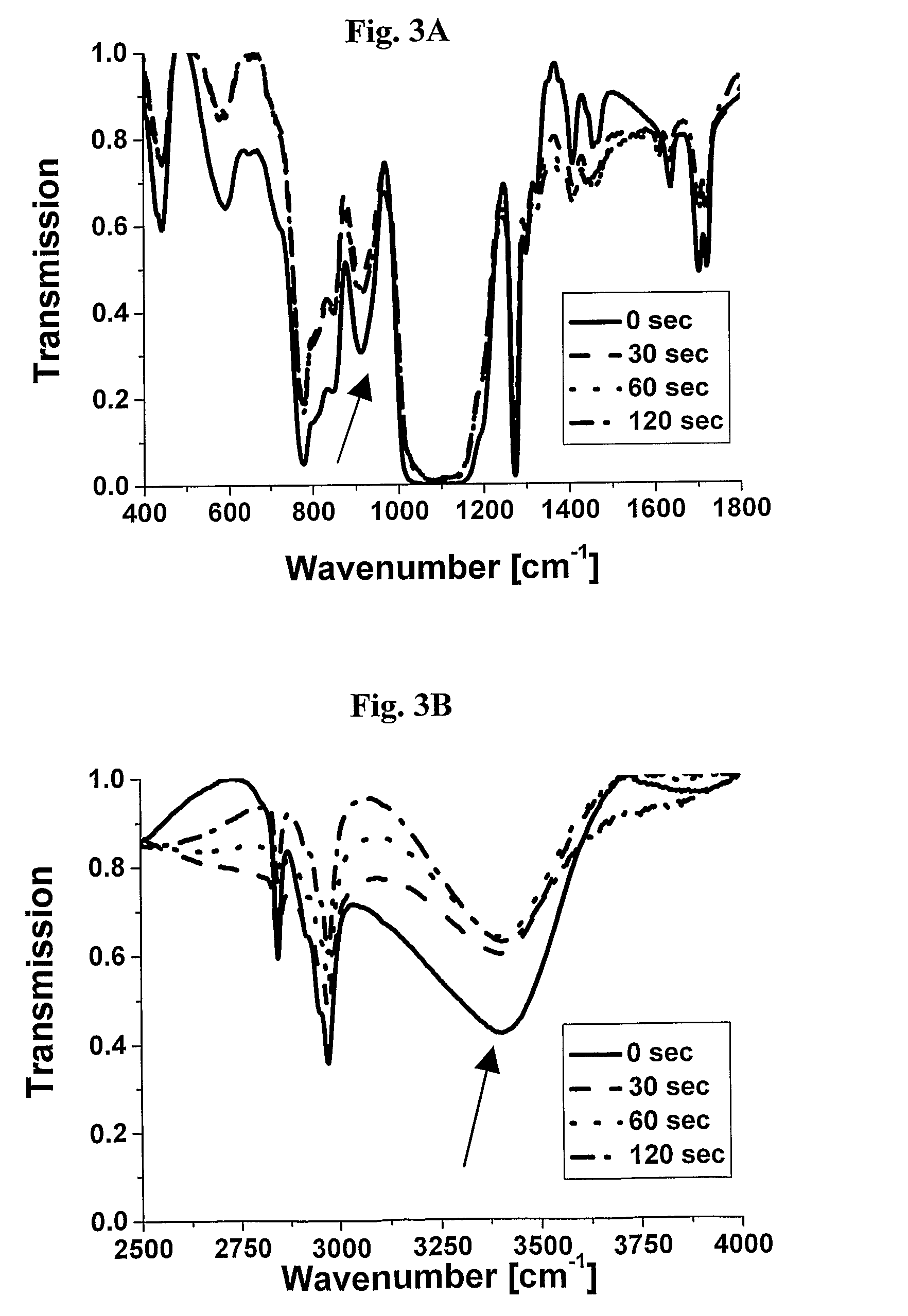UV-curable inorganic-organic hybrid resin and method for preparation thereof
a hybrid resin and ultraviolet light technology, applied in the direction of lamination, pill delivery, electrical equipment, etc., can solve the problems of slow and long drying process, limited bulk size achievable to a few centimeters, and achievable film thickness to less than 1 m, etc., to achieve low content of volatiles, low content of organic residues, and high optical quality
- Summary
- Abstract
- Description
- Claims
- Application Information
AI Technical Summary
Benefits of technology
Problems solved by technology
Method used
Image
Examples
example 1
Preparation of UV-Curable Inorganic-Organic Hybrid Resins Starting from TMOS, MTMS and MATMS Monomers
[0089]A UV-curable inorganic-organic hybrid resin, herein identified hybrid resin N-2, was prepared using the precursors tetramethoxysilane (TMOS), methyltrimethoxysilane (MTMS) and 3-trimethoxysilylpropylmethacrylate (MATMS), and water, at a weight ratio of about 3:15:2:3.85 (TMOS:MTMS:MATMS:H2O). Hydrochloric acid was added to the water as an hydrolysis catalyst at a concentration of 0.005 M, leading to a concentration of 0.0008 M in the reaction solution. All the ingredients were weighted in a semi-analytical balance (±0.001 g) and were then mixed in a 50 ml reaction bottle (Schott).
[0090]The fabrication process was carried out with an apparatus capable of heating the reaction bottle, stirring the solution in the reaction bottle and controlling the pressure by opening a valve and evacuating volatile ingredients using an evacuating pump. The initial reaction started in a closed sys...
example 2
Preparation of a UV-Curable Inorganic-Organic Hybrid Resin Starting from TMOS, MTMS and GLYMO Monomers
[0092]In this experiment, a UV-curable inorganic-organic hybrid resin, herein identified hybrid resin E-2, which is different than that described in Example 1 was prepared, using the precursors tetramethoxysilane (TMOS), methyltrimethoxysilane (MTMS) and 3-glycidyoxpropyltimethoxysilane (GLYMO), and water, at a weight ratio of about 3:15:2:3.85 (TMOS:MTMS:GLYMO:H2O). Hydrochloric acid was added to the water at a concentration of 0.005 M, leading to a concentration of 0.0008 M in the reaction solution. The fabrication process was performed as described in Example 1.
example 3
Preparation of other UV-Curable Inorganic-Organic Hybrid Resins
[0093]The following UV-curable inorganic-organic hybrid resins are prepared as described in Example 1, starting from the various combinations of precursors and water, and at the weight ratios, as defined hereinbelow, wherein hydrochloric acid is used as an hydrolysis catalyst:[0094](i) Tetramethoxysilane (TMOS), methyltrimethoxysilane (MTMS) and 3-trimethoxysilylpropylmethacrylate (MATMS), at a weight ratio of about 3:14:3:3.85 (TMOS:MTMS:MATMS:H2O).[0095](ii) TMOS, MTMS and MATMS, at a weight ratio of about 3:16:1:3.85 (TMOS:MTMS:MATMS:H2O).[0096](iii) TMOS, MTMS and MATMS, at a weight ratio of about 5:13:2:3.85 (TMOS:MTMS:MATMS:H2O).[0097](iv) TMOS, MTMS and MATMS, at a weight ratio of about 6:9:2:3.85 (TMOS:MTMS:MATMS:H2O).[0098](v) TMOS, MTMS, dimethyldimethoxysilane (DMDMS) and MATMS, at a weight ratio of about 3:12:3:2:3.85 (TMOS:MTMS:DMDMS:MATMS:H2O).[0099](vi) TMOS, MTMS, DMDMS and MATMS, at a weight ratio of abo...
PUM
| Property | Measurement | Unit |
|---|---|---|
| temperature | aaaaa | aaaaa |
| temperature | aaaaa | aaaaa |
| temperature | aaaaa | aaaaa |
Abstract
Description
Claims
Application Information
 Login to View More
Login to View More - R&D
- Intellectual Property
- Life Sciences
- Materials
- Tech Scout
- Unparalleled Data Quality
- Higher Quality Content
- 60% Fewer Hallucinations
Browse by: Latest US Patents, China's latest patents, Technical Efficacy Thesaurus, Application Domain, Technology Topic, Popular Technical Reports.
© 2025 PatSnap. All rights reserved.Legal|Privacy policy|Modern Slavery Act Transparency Statement|Sitemap|About US| Contact US: help@patsnap.com



